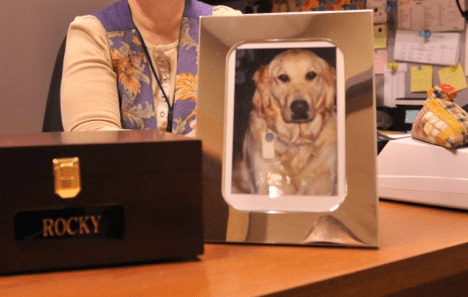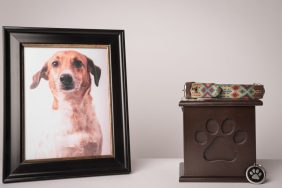By Carol Bryant, FIDO Friendly magazine
“When our 14-year-old Border Collie Natasha was put down after a long battle with chronic kidney failure, it was one of the most traumatic events I’d ever faced,” writer and dog mom Joanne Brokaw shared.
For those of us who have loved and lost a dog, we relate to those words and the accompanying grief that becomes a part of our fiber forever. Brokaw and her husband opted to bury Natasha near the pond where she loved to swim. Brokaw recalled the sun shining, the trees whispering, and time to reflect and say goodbye to her beloved dog.
Preparing for the passing of our furry friends is but one part of the grieving process; for many, understanding the options available and how to best memorialize Fido are heavy considerations.
Funeral homes provide an important service in letting people say goodbye and honor the life of a beloved pet. Brokaw learned of Harris Funeral Home in Rochester, New York, which opened the Pets at Peace Chapel. Owner Mike Harris told Brokaw, “More and more family-owned funeral homes recognize pets are part of our family unit.” Since the Pets at Peace Chapel opened in September 2009, they’ve handled more than 500 pet funerals.
Services to honor our pets also take shape on water. Captain Brad White founded New England Burials at Sea in 2006, with about 10 percent of his clientele requesting a pet burial at sea. White shared that they typically scatter cremated remains but have been asked to do a full body “non-cremated” burial at sea. In these cases, they use an Atlantic Sea Burial Shroud they manufacture with organic durable cotton so that it biodegrades within three to six months.
During a typical pet burial at sea, the Captain takes the vessel at least three miles out, which meets all federal and state requirements. Ash scattering for pets with an unattended ceremony averages about $95, with prices varying for ceremonies attended by loved ones.
“People that have their dog or cat with them— or parakeet, or even horse, as we’re starting to do equine horse burials at sea—we find they get closure when they see the cremated remains travel off into the water behind the vessel,’’ White said.
How does one know when the time has come to let go? Lorie Huston, DVM, of Providence, Rhode Island, tells her clients to consider the pet’s quality of life. “If the pet is suffering and his quality of life is diminished as a result (and there is no possibility of being able to relieve that suffering), it is time,” Huston stated.
Afterwards, Huston recommends a book written by Gael J Ross called A 30 Day Guide to Healing from the Loss of Your Pet. Pet loss hotlines, Internet support groups and chat rooms have emerged over recent years for grieving pet parents. For those who are especially grief stricken, a therapist might be worth considering.
When Sheila Dungan’s Yorkie passed away, she began a journey into grief from which she has learned and now passes on advice to others. “Allow yourself time to grieve; there is no set time limit on grief. I know I will never get over losing Sydney. Ignore anyone that says, ‘It was just a dog,’ because those of us who have been blessed to have a very special dog know they are not ‘just a dog.’”









